Margert Beardslee’s story is not all flash and glamour. Known by many ‘old hands’ as Margaret Ricardo, she commenced running as a young girl, in what I would call a Ground Zero period of women’s distance running in New South Wales (NSW). Women’s participation during the 1970s was in its infancy, a small appendage to a male dominated competitive activity.
Margaret’s attitude has been one of commitment and discipline, a grass roots approach that is steeped in the power of sport and community, and the strength of relationships. Margaret’s story is similar to the experience of other women of her era, but how she applied herself to a lifelong commitment to endurance sport may differ. Extending her involvement from active competition to the mentoring of others and administration, and owning the Coast Runners Shop, plaudits, never sought, have come her way. A reflection, she says, of an enduring partnership with her husband, Robert, rather than any singular effort on her part.
Digging into Margaret’s past unearthed some jewels, anecdotes and experiences that only distance running can deliver. It is a story worth uncovering, for some a re-telling, so others can appreciate how it was, what went before, and what drove women to participate and compete in those early days.
The Beginnings
Margaret was born near Singleton NSW in April 1958. Singleton is located in the Hunter Valley, one hour’s drive up the road from Newcastle. Her local community was a small dairy town and her social activities tended to centre on church events. Margaret’s family were members of a minority religion that prohibited participation in Sunday race events. By early adulthood Margaret was able to resolve any conflict in priorities presented by such an observance.
As a young girl, Margaret’s initial exposure to basic exercise included bushwalks. The first inkling that she may become a runner arose from her dissatisfaction with an early bushwalk experience with family. ‘They all walked to the top of the hill. I couldn’t make it to the top. Combined with finishing last in my high school 100 metres race I wasn’t happy with my fitness. I started to reflect on why I couldn’t get up that hill. So, I tried to run around the block, and to begin with I couldn’t even do that. Though I did run straight after dinner so that probably wasn’t the best time. However, gradually I was able to run a full block, then two blocks, and that’s how it all started.’ Margaret also notes that her diet was strict vegetarian and high on carbs, and running was initially a means to control body weight ‘to keep my figure’. It wasn’t until her mid-twenties, caused by difficulties obtaining vegetarian meals while overseas, that Margaret extended her diet to include small portions of chicken and fish. A practice that continues today.
Right from the beginning Margaret was competitive. It wasn’t about participating. It was about winning. ‘I love to race.’ Soon she set herself to win the Singleton high school cross country championship. She failed in her first attempt, but eventually, in later years she did win progressive titles. She broke her foot at one stage, which hindered her development. In time, she competed at all levels of high school cross country championship carnivals/events that culminated in the NSW Combined High School (CHS) Championships, usually held in Sydney at Centennial Park. Margaret really enjoyed the camaraderie of high school cross country. So much, that in her adult life it became her preferred racing discipline. It also enshrined her greatest career disappointment.
Margaret reflects that ‘as a girl, and even later as a young woman, I didn’t really have any specific goals. In hindsight this was something lacking. You need to set goals to engender commitment. Throughout my adult endurance experience I have learned that goals give you purpose and direction. Seems so obvious now, but back then I was just running, I liked to run free. I guess the fact that I was uncoached and not well guided at home in my running affected my outlook in this regard, so my training lacked structure.’
‘These days, kids get all types of help, including technical assistance and support. I furthered my running without much help but I don’t regret it and don’t feel it was a disadvantage. It meant that I worked for things myself based on what I wanted to do and it bred independence and a love of running. I didn’t know about athletics being available outside of school until I left Singleton to live in Sydney and study at the University of NSW (UNSW) where I completed a Mathematics degree, and a Diploma of Education at the University of Sydney. At high school it was more about winning, there was nothing apart from short distance track races and cross country. Only the winners got their times. No-one had a stopwatch. I thrived on competition.’
As an aside, Margaret states that she enjoyed training and racing barefoot throughout her life, particularly in cross country, and when she became involved with runners shops she sold some minimalist shoes of that era. This included importing the Arthur Lydiard Lazer shoes that had an open toes design. Personally, if shod, Margaret preferred light weight shoes with a small heel to toe drop.
-
The Three Sisters
Margaret has two sisters. Annette and Michelle are twins, two and one half years younger than Margaret. Both showed great running potential. Annette was to marry a well performed triathlete, Paul Dwyer, and became the better performed of the three sisters, representing Australia in distance running and triathlon. Annette’s competitive record included multiple Australian singlets for Ekiden Road Race events and twice representing Australia at the IAAF World Cross Country Championships (1988 and 1990). Annette’s record in the triathlon was just as impressive, when triathlon associations were in their infancy and there was virtually no support for women (the first state association was formed in late 1984 and a national body was only created in 1986). Of note, Annette won the iconic Nepean Triathlon in 1985 and 1986, Gaylene Clews having won in 1984. The ’Nepean’ holds a special place in the history of triathlons as a proving ground for Australians aspiring to international triathlon competition.
‘Michelle was the better performed during high school years, had as much talent as Annette, and was more driven, but beyond high school she was not that keen. Annette achieved all the things I wanted to, with little fanfare. She was not a showboat. She was chilled. There is not one trophy on show in her house, and she has many.’ As a sign of the closeness of the sisters, during their teens there was never any tension between them about their respective distance running aspirations.

-
The Sydney Scene
‘I only started to set goals when I arrived in Sydney in 1976, but it was still a bit hit and miss. I was invited to join the UNSW athletics club but declined. They told me the furthest racing distance was 800 metres so I said “call me when you start holding five kilometres events and longer.” And I started competing in fun runs. They were a great pathway for women wanting to experiment with longer distance racing.’
‘At this time Georgina ‘Georgie’ Moore owned the Randwick Runner’s Shop and I lived down the street from it. Georgie was to win the 1977 City to Surf. She was a member of St George Athletics Club and I met her through Bob Talay. I remember when we first met. I was at her shop late one afternoon and she asked me if I was interested in going for a run with her. She didn’t mess about. It was to be my first ever long run of 16 kilometres. Later, when Bob and I had the shop, it became a regular thing, as a Wednesday night hard hit out. Georgie was a real character, a tough competitor, and someone I looked up to. She had been competing in open men’s distance races for many years, as there were no opportunities for women to race longer events, and she eventually ran under three hours for the marathon.’
By 1978, Georgie’s shop had closed and due to a combination of circumstances, Margaret commenced a business partnership with Bob Talay, as joint owner of Talay’s Runners Shop at Randwick. Unbeknownst to Margaret this was the beginning of a long-term relationship with running shops, archiving her formal educational qualifications. ‘I formed a strong and enduring friendship with Bob, who was a top NSW distance runner in the 1960s and 1970s, and represented Australia in the 1975 International Cross Country Championships at Rabat, Morocco. Prior to taking on the Runner’s Shop I was helping Bob with his corner shop and milk run. During my studies I’d failed a subject at Uni, lost my scholarship for six months and had to get a job, so I just fell into the arrangement with Bob.’
‘We hired many runners over the years as casual employees. We were always looking for people who were really passionate about running. In the early days Andrew Lloyd and stalwart Fred Howe (a 2:22 marathon runner and ex-England international) became mainstays, and permanent employees. Andrew stayed with us for three or four years before his running career took off. Danny Boltz was often hanging around the shop. The place was a bit of a hub for the younger running set. It was long hours at the shop and fitting running in. Bob and I worked together for up to 18 hours a day. It was hard work, but also fun, just life. With little capital behind us, the shop was operating on a shoestring.’
The Talay’s ideology was naïve in many ways. ‘We weren’t out to make a lot of money. We gave elite runners discounts that we really couldn’t afford. We supported the women’s running movement. We tried to work in partnership with Athletics Clubs, encouraging participation and involvement in their club races and sponsoring community events. It was grass roots stuff that we thought was making a difference. But eventually we had to apply greater business acumen to management of the shop.’
‘Most people these days don’t know what it takes to run a business like that: no computers and bookwork until midnight. It was unrelenting but we loved what we did. It was shut the door and out for a run after a day’s business, sometimes very late at night. We were a mobile business, taking our van to community and NSW association distance running events and track meets. Initially we were given short shrift by the athletics association. It took a while to obtain approval to sell within the grounds of ES Marks Field. Early on we had to hustle, even got a hawker’s license. When Little Athletics opened up their doors to us business began to flow a little easier.’
Despite the obvious business risks, shop arrangements were expanded through franchises, something that Margaret and Bob were warned against. In true entrepreneurial spirit, additional shops were opened at Ultimo and Parramatta, plus franchises in Hobart and the Gold Coast, and agents across four States. By 1984 Talay’s had introduced the Talay Twosome, a road relay event through Centennial Park. The inaugural event was 11.4 kilometres consisting of two-person teams racing legs of 3.8 and 7.6 kilometres. The ‘twosome’ lasted three years and gave Margaret her first exposure to race directing, something she would take up with greater gusto in future years.
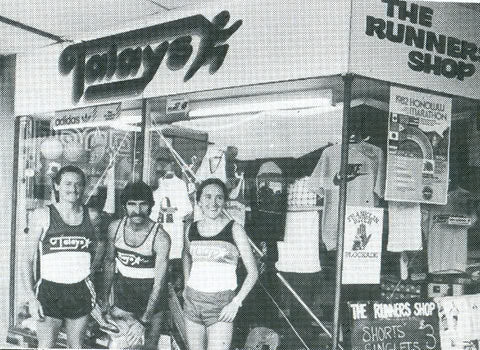
Margaret’s life was full of running. Perusal of Fun Runner issues of the late 1970s finds her name appearing in events all over the state. However, it was in 1979 that Margaret started training in earnest, knuckling down to what she once described as her first year of ‘big running’. And ‘from about 1980 onwards I trained every day, big miles, with one track session per week and a race on weekends. I also did a Sunday morning run of 25 to 30 kilometres each week with the Eastern Suburbs guys, to Watson Bay and back.’
‘I had specifically wanted to join a club that accepted men and women members so with Mick Little’s recruitment efforts, I ended up joining the Randwick Botany Club but only stayed one year. Tess Bell, the first Australian woman to officially break three hours for a marathon [authors note: achieved in 1975], and Penny Just, were also members. I didn’t feel as well looked after as I had hoped, so I went on to join Eastern Suburbs. I wore its membership like a badge of honour, as it included many of the top NSW female distance runners of the day such as Eleanor Cody, the Ganzevoort sisters and Kerryn McCann.’
‘Well known Sydney coach, Jack Pross, noticed me and invited me along to his group occasionally to do hill repeats but due to my shop commitments I wasn’t able to attend that often. He told me that I was “running with my bum on the ground” and he wanted me to do drills to get up on my toes. I was always too tired and fatigued from training and often chewed out the back of my shoes from all the miles run. His advice helped a lot. Though in hindsight I trained daily on the very hilly terrain of the Eastern Suburbs, so in a sense I did do some hills. Anyway, that’s how I justified it. Later, my husband, Robert Beardslee, actually encouraged me to do speedwork and he found it surprising that I could never break 30 seconds for 200 metres.’

Source: Fun Runner: Dec 82/Jan 83 Vol 4 No 5.
‘I met Robert at the 1982 Australian Cross Country Championships in Brisbane. He had taken a franchise shop on the Gold Coast, in addition to manufacturing the Bill Rodger’s clothing line to distribute in Australia. He negotiated a merchandising arrangement with me, for the Randwick shop. However, we were soon living together and after three years of being a couple we married in 1985.’
Robert is an American, hailing from Groton, Connecticut, New England. A 4:07 miler, he managed to run 2:32 for a marathon. He went to school and trained with the likes of Amby Burfoot and Bill Rodgers, Boston distance running legends. Rodgers actually stayed at Margaret’s home in 1982 as part of his Australian trip when he won the Melbourne Marathon. Prior to settling in Australia, Robert spent some time training with Arthur Lydiard’s group (1968), and later was coached by Murray Halberg (1972), travelling back and forth between New Zealand and the United States. To this day Robert has strong family connections in New England. When Robert moved to Sydney, he worked at Scots College where he had a lot to do with high school basketball and the commencement of Sydney’s Great Public School (GPS) cross country circuit.
Reflecting on the personalities of the Sydney scene, Margaret has a high regard for Frank McCaffrey. Frank was expat Irish who joined the British Navy just prior to World War II and found himself a prisoner of war for four years. He was an avid writer for Fun Runner magazine and wrote his life story “With the Sun on My Back”. She describes him as ‘an ideas man, who was smart, funny, and humble to go with it. Frank was an absolute gentleman. He’d go about his business quietly in the background, sponsoring and helping others, particularly aspiring young athletes who needed financial assistance to get to a race. He was able to generate enthusiasm by his presence. He’d turn up everywhere in his combi bus promoting people and race events.’ Margaret considers he was a major influence on the Sydney and NSW scenes, particularly due to his contributions to the iconic Fun Runner magazine.
-
Equality and Other Things
At the turn of the decade, late 1970s to early 1980s, there was a group of younger women distance runners like Margaret mixing it with an older generation who had been trying to break the ‘gender barrier’ in NSW for some time, but they were not really taken seriously. These women had been pushing the boundaries of the Women’s and Men’s Amateur Athletics Associations by joining the men’s association and entering men’s races, some maintaining dual membership. They also participated in mixed races in fun runs and open club races (men’s and women’s associations were to amalgamate by April 1982). The participation rate for women, even in mixed races, was very low, generally less than 5% and occasionally hitting 10% for larger events. However, the advent of women’s only road races in Australia sponsored by Avon and Sussans helped to move things along and there was a rapid increase in women’s participation and a tangible improvement in women’s distance running standards from 1979 onwards. Margaret was an avid participant in these women’s only series, an integral part of the distance running sisterhood that was gaining momentum and exploded into the eighties.
Margaret puts it this way, when describing the late 1970s: ‘The early female distance runner’s performances were unsung and not really acknowledged. Race results were male centric. There were no separately listed female results, apart from the first female, if you were lucky. You had to dig into the results searching the lists for your peers by name and initial. Typically, full results were published for the top 10 men and only the winner of the women’s category got a mention, and maybe the positions of some others like the second and third placegetters. It was not unusual for times not to be provided for women, or for women not to be identified separately within results. You just had to fit in with the men’s world.’
Apart from competition, throughout her life Margaret has been engaged in civic activities, charitable organisation and sponsorship of good causes, something that stems from her upbringing. One of many examples is Margaret’s participation in a team of ten NSW women runners in 1979 that ran a ‘relay’ from the Melbourne General Post Office to Sydney’s Martin Place, a distance of 889 kilometres. The relay was organised by Fred Hollows to provide funds for the Aboriginal Medical Service. Though it was 45 years ago, the names of the participants fall from Margaret’s lips like it was yesterday: Merri Tindale, Caroline Vaughan, Nancy Johnson, Brenda Sheens, Jean Medlock, Penny Waters, and Mora Main, Anna Schroeder, Mary Murison and Sandra Fleck reserves. All of these women were prominent in the distance running scene, one way or another. The relay arrangements meant that each woman covered 5 kilometres in team rotation for an individual total of around 30 kilometres per day over three days. The women raised $25000 via sponsorship from Myer and beat the ‘record time’ that had been set by a team of firemen from Melbourne.
The kookiness of the 1970s and early 1980s brought with it some investigation of how a woman’s biology is affected by endurance running. Margaret recalls her involvement in a study into this very issue, by Cumberland College, and later Boston University. Margaret and other running colleagues were used as ‘lab rats’ for want of a better term. You have to remember that this was when the furthest Olympic distance race was 1500 metres and women’s experimentation in marathons was receiving global attention.
-
Racing
Margaret’s personal bests were:
3000 metres 9:59.7, Sydney, 1983
10,000 metres road and track: 36:18 and 36:05, respectively, both in Sydney, 1982
City to Surf: 52:33, Sydney, 1985
Half Marathon: 81:20, Rochester, England, 1983
Marathon: 2:54, Boston, 1983
While Margaret raced well and was always vying for top honours in NSW, her lack of targeted training, and faster work, limited her to the second tier of women’s distance running performers nationally. As evidenced by her personal bests, the further Margaret raced, the better she performed comparatively. However, despite any deficits in training, she did represent NSW in the marathon (1980) and on four occasions at the Australian Cross Country Championships, 1982 to 1985 inclusive.
Margaret raced regularly in all of the popular NSW open/mixed events of her era like the Harbord Diggers 30 kilometres, the Sutherland and Sydney Striders Half Marathons, the Randwick Runners Club 22 kilometres, the Parramatta 10 miles, and of course, the City to Surf. As she says ‘I raced a hell of a lot of half marathons.’ After placing third in the inaugural Striders Half Marathon of 1982, 84:30, she performed consistently in this difficult event improving to 83:24 by 1986, placing fifth. Margaret’s 22 kilometres time of 82:55 in the Randwick race of 1982 is easily equivalent to a sub-80 half marathon. She loved the Parramatta ten mile classic, achieving a PB of 60:05 in this event. ‘I so much wanted to get under 60 minutes but it was not to be.’ She ran it many times finishing behind such winners as Liz Hassall and Angie Cook.
Though 10000 metres was Margaret’s preferred distance her performances fluctuated. One of her best performances was sixth (and second NSW counter) at the 1982 Australian Road Championship in Sydney, won by Victorian Sally Pierson in a canter, 33:57. Margaret ran 36:18, 42 seconds behind second place Janis Ham of South Australia, with Quelch finishing 10 seconds ahead of her in fourth. NSW won the team event.
Margaret ran the City to Surf on 15 occasions from 1984 to 2009, only missing this event due to injury or other state and international endurance racing commitments. Her best time was 52:33 in 1985 for ninth and her best placing was seventh in 1984 in a time of 52:49. In the 1996 event, aged 38, Margaret was competitive in the W35 age category, finishing 22nd woman in a time of 53:21. Of interest, Annette’s performances included 49:54 in 1987 for fourth, and 49:39 in 1990 for fifth, 10 years later running 52:35 for ninth, aged 39.
5.1 Cross Country
Margaret had a long association with cross country in NSW, consistently placing in state championships, and even winning the short course championship in 1999, aged 41. Margaret adapted to, and raced comparatively well, in cross country events. She loved this discipline and harboured a lifelong goal of making the Australian Cross Country Team. Her biggest disappointment was not making that Australian team. At her best in 1982 and 1983, the women were ‘only running 3000 metre track events. The 5000 metres was not something that we raced and as my 3000 metres best was comparatively slow, I think that due to this, any claims I had for selection were discounted by the Australian selectors during this period.’
Margaret entered the national cross country fray in 1982. Racing barefoot, she achieved her best placing of seventh for the Australian Championship at Hobart where the distance was 4000 metres. She also placed seventh in 1983 at Brisbane where the distance was 8000 metres and she was first NSW counter. In 1984 at Perth, over 8000 metres again, she managed tenth. In 1985, on home turf at Lansdowne, Margaret finished 21st. This was a rare occasion, where she beat her sister by 12 seconds. Annette went on to place fifth in 1987 (second Australian) and 1990, and second in 1988 and 1989.
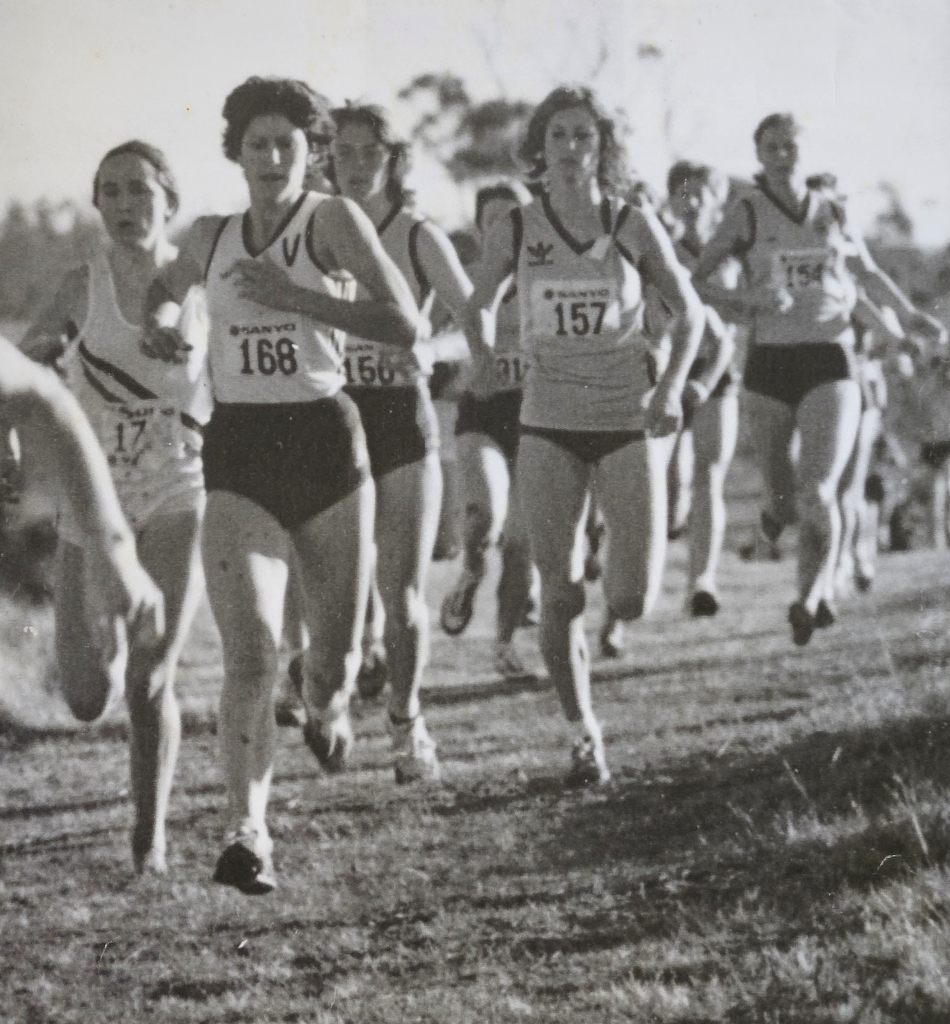
Examining the fields for these four races there was a mix of track, road and marathon exponents, young and older, middle and longer distance exponents, that cross country tends to attract. In real terms, Margaret’s best performance was probably 1982. In a large field she finished only 26 seconds behind the winner, Megan Pye (nee Sloane) of Victoria and 12 seconds behind NSW track speedster Alison Quelch who finished third. Margaret had finished ahead of all her other NSW teammates, notably Jenny Ganzevoort and Penny Just, who had thrashed her in the NSW Cross Country Championship. Pye represented Australia in track, cross country and road disciplines, achieving a 2:37:50 marathon and competing for Australia in the 1983 World Championships marathon at Helsinki. In hindsight, Margaret considers that all the lead up ‘marathon training’ gave her strength for this race, countering her lack of speed.
5.2 Track
‘I wasn’t interested in track. I was not so good at it. Two of my most memorable track races were a 9:59 for 3000 metres, finally breaking 10, and a 36:05 10000 metres, both at Sydney’s ES Marks Field. During the 3000 metres I had great track side support from Con Hadjidakis, Lawrie Whitty’s coach and shadow, urging me on that “you can do it”. During the 10000 metres, which was a mixed race, I had to be cajoled to stay in the race. I pulled over to the side of the track to withdraw, as I felt outclassed and had been passed multiple times by male competitors. But I was encouraged to stay the course by Bob Talay and Fred Howe. I was quite pleased with the outcome.’

Margaret recalls racing in a 10000 metres invitational track race in Melbourne in December 1983. There had been a big build up as part of a national track series promotion but it all fell flat. The race was run at 9:00pm as Victoria was in the middle of a three day heatwave. Despite being nationally televised, only a small number of competitors arrived at the start line. The field included Penny Just, Kerry Saxby (NSW, of international racewalking fame), Shane Barrett and Kerry Whannell (both Queensland) and a Kiwi who came especially from over the ditch. There were no Victorians! The Kiwi won in 35 plus minutes. Margaret describes it as an ‘embarrassing exhibition’ as everyone ran very poor times.
5.3 Marathons
Margaret ran quite a few marathons during her early to mid-twenties. ‘In training I used to log big miles, consistently in the 80 to 90 miles per week range, with no speedwork to speak of. My training sat at this volume all year around for four years until 1985/86, when I suffered a neuroma of my right forefoot. My marathons used to really hurt because although I was doing the miles, my lack of hard faster work affected how I felt in a race. I didn’t really know how to train properly for marathons. Sometimes, if I didn’t hit my planned weekly mileage, I was tempted to get out at night on the last day of a training week to hit the mark.’
Margaret’s first marathon was the Sydney Avon Marathon in 1979, aged 21. ‘I ran 3:13:17 for fourth’. By the age of 27 Margaret had raced nine marathons. This included three Sydney Avon events (1979, 1980, 1982), two Australian Championships (1980 and 1985), Gold Coast (1979), Boston (1983), and New York (1985). Combined with racing the Diggers 30 kilometres, ‘I became well and truly sick of running that Manly to Palm Beach stretch of road.’
Margaret had a casual attitude towards the marathon, never really chasing the elusive sub-3. She always thought she would break 3 hours. ‘Sub-3 gave you bragging rights in the women’s distance running fraternity, and I thought it was just going to happen as a matter of course.’ But Margaret was to learn the hard way that it just doesn’t come that easily, achieving sub-3 only once in her career, on her seventh attempt, under difficult circumstances, at Boston.
There was much excitement about the advent of the Avon Marathon series in Australia. However, the first running of this women’s only event in Sydney on 8 July 1979 showed there was still a long way to go before women’s distance running achieved a higher level of legitimacy in Australian athletics circles and the broader community. Peggy Smith’s race report in the Victorian Marathon Club newsletter of September 1979 shines a light on how it was:
‘Starting from Manly, the course commenced with a loop of about 4km and then went along Pittwater Road to Bayview and back. Although the course had been described to me as flat, two of the hills we encountered were anything but. There were numerous intersections to cross, these were not too busy when we started at 8:00am, but by the time we reached the turn the road was too busy to run on, and we spent most of the way back dodging pedestrians, kids on bikes and dogs along the footpath. Under normal circumstances, if there was a large field in the marathon, I don’t think these things would have been noticeable. As there were only about 20 starters it meant that by the 20 mile mark it was possible to have been running for the previous 5 miles without glimpsing another runner. This feeling of isolation does not make running marathons any easier, that’s’ for sure!!’
Notably, the first drink station was at the 5 miles (8 kilometres) mark. While the runners were treated like royalty post the race and well looked after, the race organisation itself was rudimentary given the supposed status of this new event. However, learnings were gleaned and the Avon series was definitely the start of a new beginning for women distance runners, that Margaret was a part of. The first two placegetters ran well facing a headwind ‘on the way out’ in conditions that heated up towards the end: Tess Bell (2:55:37) and Sue Hill (2:56:58) won all expenses paid trips to Germany to compete in the International Avon Marathon. Mary Murison was third in 3:08:04. Sue Beisty, first Masters runner, was fifth in 3:17:54 not far behind Margaret, having raced close to each other much of the way.
Two months later Margaret finished second to Murison in the inaugural Gold Coast Marathon, 2:58:17 to 3:09:08, the third placegetter, Zenda Malanga, nearly 40 minutes behind Margaret in 3:47:53. Business partner, Talay, finished fourth outright in 2:36 plus. Run over a six laps course, newspapers reported that competitors were affected by a strong headwind when running south. As a side note, Carolyn Sigmont, wife of the race winner, Eric, a well-known Glenhuntly distance runner, finished fourth in 3:49:14. And maybe this is not a fair comparison, but 3:47:53 would have placed 365th in the women’s category of the Gold Coast Marathon in 2023.
The next year Margaret ran ‘Avon’ again at Manly. This was the selection trial for the Avon International event in London. Margaret finished ninth in 3:04:23, nine minutes faster than her 1979 performance, but five places back. NSW big guns Liz Hassall and Angie Cook were first and second in 2:45:32 and 2:50:26. Victorian Joan Cameron who was also selected for London, ran out of her skin to break three hours for the first and only time in her career with 2:53:37 for third place.
Margaret played a role in a little bit of Australian distance running history, finishing sixth in the 1980 inaugural Women’s Australian Marathon Championship at West Lakes, Adelaide. In the absence of Cook and Hassall, Caroline Vaughan, Beisty, and Margaret represented NSW. Held in wet, windy and frosty conditions, they finished fifth, sixth and seventh respectively one minute covering all three, 3:06:58, 3:07:12 and 3:07:58. The first three placegetters were all Victorians, Jane Kuchins 2:53:23, Megan Pye 2:56:08 and Barbara Byrnes 3:00:10, with Queenslander Kerry Whannell, 3:02:47, splitting the Victorians and New South Welshwomen, in fourth.
At this time, women’s marathon fields exhibited a wide range of ages and abilities. It was a time of experimentation. For instance, if you examine the three NSW reps in this race alone, there was a twenty years age difference between Margaret and the 41 years old Beisty, Vaughan sitting in the middle and also a relative novice to running. This was typical of the fields at this time, many ‘coming and going’, testing themselves through a period of marathon racing, at the beginning and ends of their careers, or somewhere in-between, some regularly achieving low 3s and then like shooting stars, such as Cameron’s experience, eventually smashing sub-3 as a one off and career best, and petering out thereafter. There were just as many others competing frequently and over longer periods, never quite getting there but enjoying the new challenges that a marathon presents. ‘Tracksters’, middle and long distance exponents, road racers, and cross country specialists all having a go.
In 1982 Margaret ran her third and final Avon Marathon at Manly, finishing sixth in a time of 3:01:17. Race reports comment on the superb organisation of this event, an improvement since the 1979 edition, and the positive vibes for women participating, which included half marathon, 8 kilometres and 3000 metre races. The field was large compared to 1979, with over fifty finishers. Margaret ran a solid race against a good field, a number of more fancied competitors dropping out. In the final wash up, the first five ran under three hours, with Georgina Moore-Price, at 34 years of age, achieving 2:58:48, her one and only sub-3. In a close affair, the first three placegetters, were Barbara Byrnes (Vic), age 30, 2:50:49, Margaret Reddan (Qld), age 29, 2:51:01, and Dot Browne (Vic), age 41, 2:53. Reddan ran from the middle of the field, passed Browne at 35 kilometres and just failed to catch Byrnes. All three were pioneers of the Australian women’s marathon running scene and became prolific sub-3 runners throughout the 1980s. However, for Margaret, her best was yet to come.
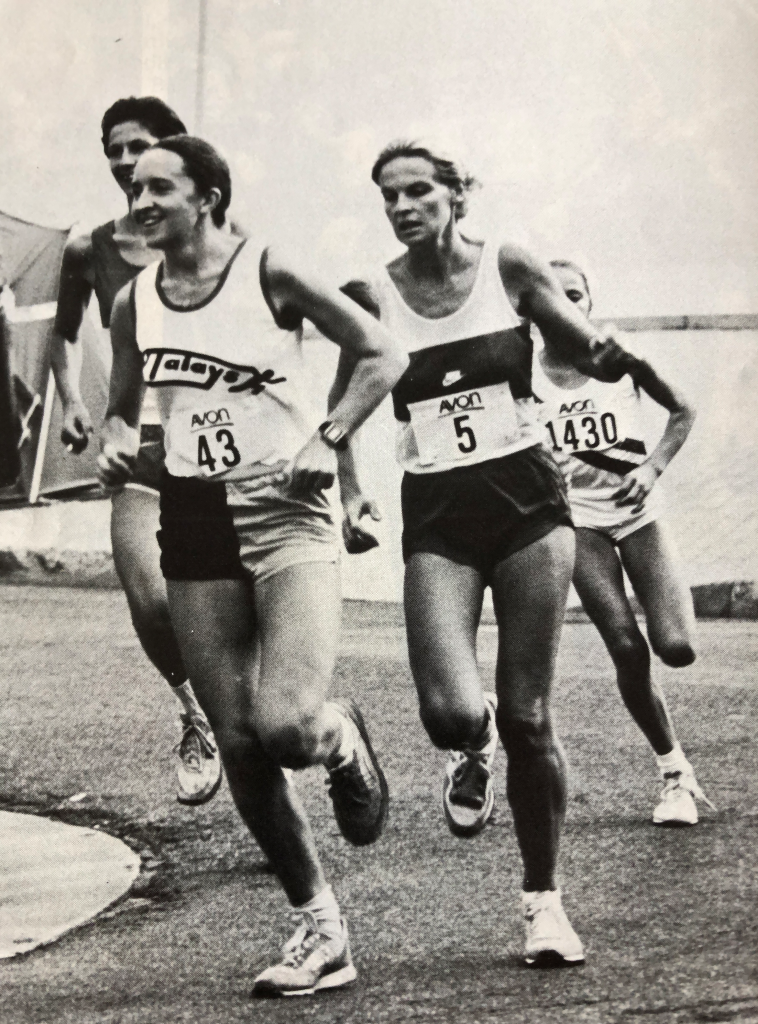
5.3.1 Boston and Marathon Wind Down
Margaret ran the 1983 Boston Marathon with her husband (he ran 2:32). She smashed her personal best by seven minutes, hitting 2:54 dead at the finish, but knowing it took her one minute to pass the starting line because of the narrow roads and large number of entrants. Apart from complications at the start, she was fortunate to achieve a sub-3. Naively, Margaret raced in new shoes, and had to stop twice to take her shoes off to check on massive blisters that had developed in her arches! Margaret went into it thinking it was just another marathon and couldn’t understand why Robert was so excited about it. She recalls how wrong she was, describing how this race was an eye opener, and today uses superlatives like ‘it is a big deal, it is the mecca, the pinnacle, the heart and soul of running in New England’. Margaret couldn’t get over the size of the crowds lining the streets, shouting and chanting her name, compared to her local experience of ‘dodging surfboards along Manly foreshore while racing marathons.’
If she was ever going to achieve a sub-3 it was going to be at Boston. As evidence of how much standards had improved in Australia, this performance ranked Margaret 19th nationally for 1983/84. Post Boston, Margaret consolidated her career best road form, winning the Rochester Half Marathon in England, in a lifetime personal best of 81:20.
In her next marathon, two years later, Margaret finished thirteenth in the 1985 Australian ‘Wang’ Marathon Championship held at Sydney in 3:01:40. Eleven women achieved sub-3, Kiwi, Ngaire Drake winning in 2:38:48 from American Laura Albers, 2:40:41, and third place filled by Queenslander Elizabeth Patmore, 2:45:47. Robert ran with Margaret the whole way, finishing in the same time.
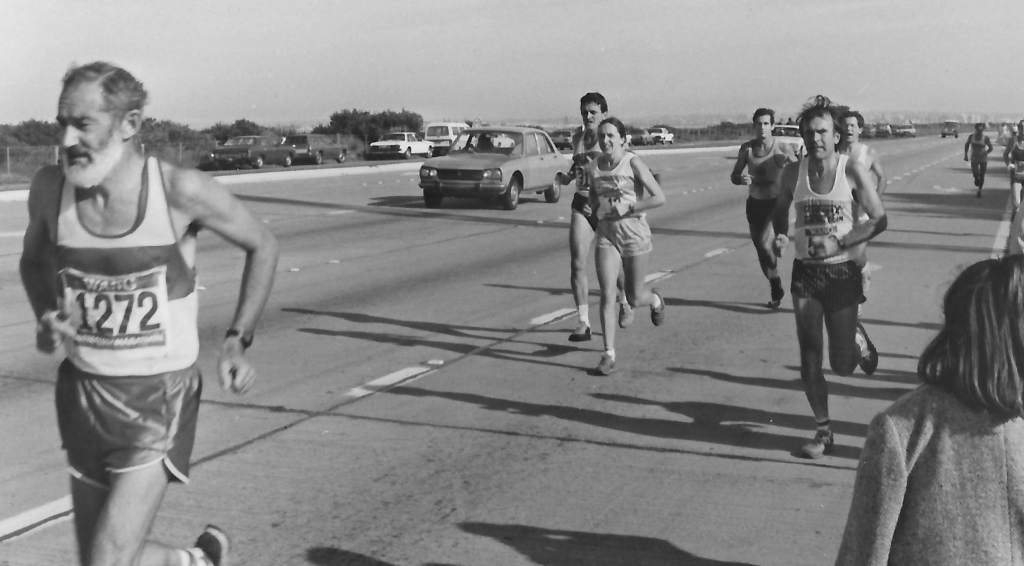
By this time, the improvement in Australian women’s standards put paid to any notion of women claiming bragging rights for a sub-3. The world had moved on. Though something to aspire to, sub-3 was now commonplace, and viewed in a similar light as the men’s sub 2:30.
Margaret’s last competitive marathon was 3:04:52 at New York in 1985, aged 27, the neuroma curtailing future distance racing aspirations. Thereafter, Margaret transitioned to multisport events. Margaret states that apart from the renewed enthusiasm to run in Boston’s Centenary race in 1996 she had lost interest in marathons. She came out of marathon retirement in 1995 achieving a time of 3:18:30 in the Sydney Marathon to qualify for the Centenary. She states that she ‘went for the experience’, running the first half erratically ‘like a dog weaving through a crowd’, before hitting a steadier pace to finish around 8000th in 3:35. From a field of 40000 registered competitors, plus a large cohort of unregistered ‘bandits’ (everyone wanted to run Boston), this was no mean feat.
While Margaret had a rich background in marathon running, she has always been circumspect about racing them at a young age. She was sometimes quoted by Frank McCaffrey in Fun Runner discouraging the under 25s from racing them. Despite, or more likely because of her own experience, Margaret maintains this stance in her coaching advice to others. One of her central concerns is the potential damage to a person’s bone development. As she says ‘bones haven’t formed properly’ at a younger age. ‘The mileage needed in training places a lot of stress on younger athletes, and there can also be undue mental exhaustion because of the toughness of the event.’
-
Multisport Transition and the United States Experience 1987 to 1991
Post her marathon experiences, and no longer able to run at previous levels due to the neuroma, Margaret took up triathlons. ‘Paul Dwyer, Annette’s husband, encouraged us to have a go at them. Annette needed someone to train with, so that’s a big reason why I made the transition. But I wasn’t a strong swimmer. I would smash the cycle and run legs, but it was such a lonely race time trialling toward an occasional podium. This was a big discouragement, so eventually I settled on duathlons [author’s note: international standard is a 10km run, 40km bike ride, 5km run]. However, we both competed in the first Mutual Benefit Half Ironman triathlon event in Australia, held at Manly. I’m pretty sure we were the only women competitors and we finished together to share the win. Annette went on to win the first Ironman race, the 1985 Triple M Triathlon – a 2.8km swim, 180km bike and 42.2km run – finishing ahead of her husband.
Needing a change from the Australian running shop business, from 1987 to 1991 Margaret and Robert relocated to Robert’s home town of Groton Connecticut in the USA. Here, Margaret ended up working at a bicycle shop. This was largely on the recommendation of local running identity, John J Kelley, the 1957 Boston Marathon winner and owner of the local runners shop in Groton. John had been Robert and Amby Burfoot’s high school running coach. Robert took ownership of an antique auto business.
‘As it happened soon after we arrived the Bud Light National series race was in Boston, so I entered it, my race performance affected by an inferior swim. At this time Coors Light sponsored a National Duathlon series of 5km run 30km bike and 5km run. This suited me perfectly and after fifteen races across the Nation, I finished second in the series in 1989. Sadly, in the next year just six weeks before the Series started, I suffered a badly sprained ankle that compromised my season. I managed to finish sixth in the National Series. For these two years I was ranked “All American” by Triathlon USA. This was a huge honour! The beauty of this Series was the offering of equal prize money.’ However, during four years of living and racing ‘on tour’ in the USA, Margaret only earned enough from the circuit and additional races to cover travel costs and accommodation. She made some great friends and was inclined to remain in the United States, but family ties and better job prospects meant a return to Australia.
Margaret was of an era where all well performing women athletes needed to be active in attempts to improve women’s equality. Margaret and her sister, along with many others such as Gaylene Clews, were part of a movement that broke new ground. Women who were competing as part of elite team arrangements were initially receiving less or frequently no prize money whereas men were better catered for in this department, but this changed over time, to equal prize money, and the depth in women’s standards improved in tandem.
Margaret reflects that she suffered more serious injury from multisport events, than during her running specific career. ‘By owning a shop, I was exposed to a lot of running magazine articles and books about injury prevention and cure and rehab injury techniques. Since being on the Coast I have always maintained an ongoing relationship with local Central Coast physios, podiatrists and sports orientated doctors. This has helped me get around injuries and maintain fitness. Since a young age I have liked to use water rehab strategies. I know that elite athletes such as John Walker ran in water and Mary Slaney used a water belt. Sydney distance runner Dave Brennan ran squads in water running and early in my career I used to swim in the cold waters of Clovelly beach during winter.’
‘Except for an anterior cruciate ligament injury in 2000 as a result of a steeplechase race, overall, I was lucky throughout my running career. I didn’t have too many issues apart from the neuroma. Just the usual niggles including ITB syndrome that I had to manage. But some of the injuries I suffered in multisport were quite traumatic. I had two heavy bike crashes in 2001 that caused multiple injuries, including concussion and a broken collar bone, that I had to overcome and two years ago I broke my left knee (patella) in a bike fall.
6.1 Masters Multisport Achievements
Later in life, during an extensive period of multisport, open events and masters, Margaret competed with some success in International Triathlon Union (ITU) World Duathlon and Oceania Triathlon Union (OTU) Duathlon Championships. Highlights include:
participating in the ITU Duathlon World Age Group Championships at Huntersville North Carolina 1999, open event won by Jackie Gallagher;
finishing 37th in the ITU Duathlon World Championships in 2000 (Calais) Elite women open race. Margaret was a member of the Australian Elite Team that included Jackie Gallagher;
winning the W45 age category of the ITU Duathlon World Championship in Geel Belgium in 2004;

finishing fifth in the W45 age category of the ITU Duathlon World Championship at Newcastle NSW in 2005, one second behind Annette and 28 seconds behind third placegetter. Margaret maintains that she crossed the finishing line holding hands with Annette, but officials split them in the results;
finishing ninth in the OTU Duathlon Oceania Elite race at Canberra in 2007, aged 49, 12 minutes behind the outright winner;
winning the W50 age category of the OTU Duathlon Oceania Championship at Newcastle NSW in 2008; and
winning the W50 age category of the Oceania 24 hours mountain trail bike race at Mount Stromlo in 2008.
-
Administrator and Community Leadership
7.1 The Central Coast
Arriving at the Central Coast in 1991 Margaret joined Terrigal Trotters for a few years before setting up Tuggerah Lakes Athletics Club in 1997, later renamed Mingara. She saw this as an important step in developing a pathway for younger athletes. Margaret has performed a range of administrative office holder roles at the club, Central Coast and state association levels since then. Notably, from 1997-2000 Margaret chaired a local committee to establish a synthetic track at Mingara, and was a driving force behind the development and opening of the Mingara Regional Athletics Centre in November 2000.
Margaret has played an integral role in the organisation of club and state championship events held on the Central Coast. This extended to an active involvement with athletes as a club coach. In 1995 Margaret started coaching a small elite group of triathletes, and expanded this to the Tuggerah Lakes Athletic Club in 1997. This group continues today. You will regularly find Margaret and Robert at the Mingara Synthetic Track mixing with a large group of enthusiastic runners aged from 12 to 80, whose preferred events range from 400 metres to ultramarathons.
As if this wasn’t enough, in 2009 Margaret and Robert bought the Central Coast Runners Shop, and in 2018 purchased the original shop in Randwick. Any aspirations for a teaching career were long forgotten, the intervening years from 1991 spent managing a store at Sydney University, running a screen printing business, and managing her brother’s computer shop. The runner’s shops are much more than retail outlets. Continuing in the Talay tradition, they are hubs for athletics and endurance sports information, a centre of encouragement for developing athletes and community relationships. Margaret states that given a tough business environment, ‘it is harder now to contribute in tangible ways to community outcomes but I think we have achieved a level of sustainable community integration. We do our bit by sponsoring local events such as the Bay to Bay, Bouddi Coastal Classic and the Great North Walk. And we are engaged with schools, the local triathlon scene, athletics clubs and coaching groups.’
‘I’ve been over-recognised‘. That’s how Margaret describes the accolades that have come her way. Ever present in Sydney and Central Coast running scenes Margaret is highly regarded for her supportive nature, encouragement of others and pragmatic outlook. During her sporting life, with Robert in lockstep, she has rolled up her sleeves and got things done.
The list of awards includes:
- Order of Australia Medal (OAM) 2016
- Life Membership of Athletics New South Wales (ANSW) 2016
- ANSW Country Club of the Year Award 2020
- ANSW Club Administrator of the Year Award 2020/21
- Athletics Australia Platinum Service Award for 40 Years Club Service 2022
Margaret states that performing administration and organising roles ‘can be a thankless task and you can never please everybody where competition is involved and there are winners and losers. There is always someone whose goals and aspirations are not met and this can sometimes generate grievances and bad feelings, unnecessarily so. If prize money is involved this complicates things further. But as long as you do a good job, the best that can reasonably be done in the circumstances, that’s all anyone can ask. It’s important that you not take things personally. For many administrators there is a recognition that if they don’t do it no one else will.’
Margaret is ‘not wanting pats on the back’ but when I asked her what she was most proud of, she mentioned the OAM. This award was attributed to her longstanding activity within the local sporting community. She stated ‘it was such a shock to receive this award, though I have to admit it did feel good to be appreciated. But really, I didn’t want a medal. What I needed was more helpers. Actually, Robert’s assistance was overshadowed by my award. We work as a strong partnership and he is much more than a sidekick to everything I have achieved.’ In terms of her life membership, she felt honoured but considers there are many others more deserving than herself.
7.2 Health
Margaret had a brush with breast cancer when approaching sixty years of age. From Robert’s point of view, as the person who knows Margaret best, he considers her advocacy for breast cancer survivors her most significant life achievement. Particularly, the bravery she exhibited by making her story known to others, and assisting in the education of women about breast cancer.
In an interview with Scott Levi, of ABC radio, in 2019, Margaret outlines the scenario she faced in an open fashion. In summary, Margaret told her audience that having trained for six months for a five days mountain bike race in East Timor, she had been avoiding her breast screening, but was eventually persuaded by a good friend to have it done. The screening found something and she was told she needed to have a second biopsy, but despite medical advice, she delayed it until after the race. She states that during the event she competed against women half her age, but on the fourth day she suffered heat stroke and ended up sitting out the fifth day. Margaret maintains that during the whole six months that she’d trained for the race this was the only indication her body may not have been coping, but apart from that fourth day she felt pretty good. In the same breath she acknowledged that breast cancer is a silent killer and in hindsight she recognises it was reckless behaviour to opt for the trip at the expense of more immediate medical investigation.
Two days after returning to Australia she had her biopsy and one week later she was advised a lump had been found that needed to be removed. Successful surgery occurred soon after and Margaret became heavily involved in education services about breast cancer in her local community. One of her awareness promotion activities included riding 60 kilometres on her bike, on her sixtieth birthday, while having chemotherapy. This was done with advice from her oncologist. She also contributed her story of discovery about breast cancer, and the value of exercise in the recovery process, to a compendium compiled by Dr Mary Ling, a Central Coast breast and general surgeon.
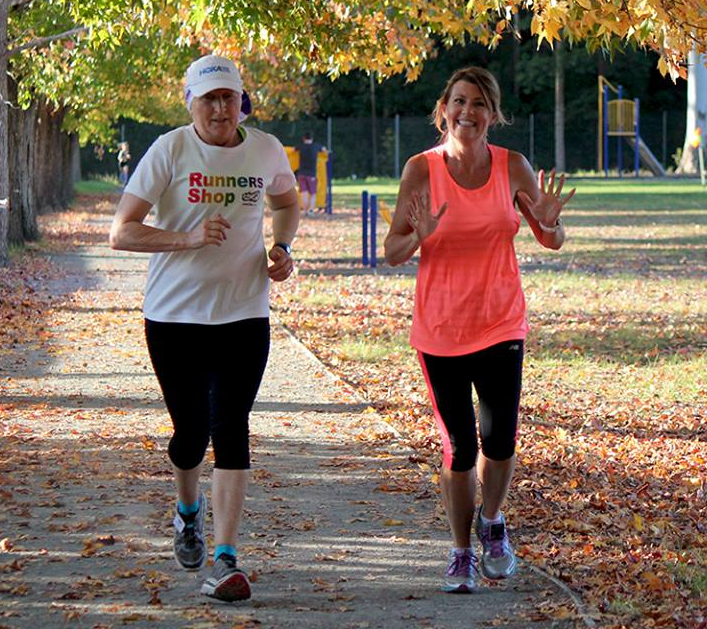
Source: Beardslee Family Library.
Margaret also recalls participating in the Great North Walk 50 kilometres race from Teralba, a suburb of Lake Macquarie, to Congewai in 2018. This was a post treatment goal that was important to her. Treatment ended in June and the event was held on 9 September. Accompanied by Suzy Woodbury, her friend and an employee of the Coast Runners Shop, ‘we made the distance, narrowly making the first cut off at Heatons, and then around an hour inside the final cut off for finishers at Congewai.’
Margaret’s example has been praised by media, and health and community representatives. Despite the uncertainty that surrounded her health and wellbeing, one thing that anchored her mindset was the benefit of exercise to her recovery, and the all clear she received from her oncologist and surgeon to stick with it. Five years on, though check ups continue, Margaret remains sanguine. She is feeling happy with life, while living the reality that once you go through such a process it never really leaves you. And of course, she continues to engage in endurance sports.
7.3 Key Message
Margaret reflects that despite any disappointments in racing performances, it is important to enjoy any activity you are involved in. Friendships and camaraderie will likely follow. Participate and compete regularly but don’t take things too seriously. Stay engaged with your community and look after your health, first and foremost, and the reward of deep personal satisfaction will also follow.
-
Concluding Comments
During the time it took to write this article, at 65 years of age Margaret underwent surgery to her knee for a torn meniscus. Typical of Margaret, this is something that she saw as an irritant, a minor setback that she would inevitably overcome. An outlook on life that is about grabbing what’s next with both hands.
Her life, in endurance sports, and more generally, encapsulates a fighting spirit where perseverance wins out. Margaret is altruistic to her core, watching out for others, downplaying her own successes and the level of commitment she has exhibited. With Robert by her side, she continues to support her community, despite all the barriers that have been put in her way.
Margaret was fortunate to witness, and participate in, the rise of some great distance runners and triathletes, men and women, in an era when things were much simpler, but not without its difficulties and disappointments. She has been a constant in the NSW distance running scene, always ‘giving back’ in some way, along the way. Yet she made her own luck by hard graft, in sport and business.
As I finish this article I reflect with amazement on the longevity of Margaret’s active involvement in endurance sports, and her attachment to the distance running community, how she has breached the years with pragmatism and a ‘can do’ attitude, and still does, for there is always work to be done. For a young athlete who started out with an outlook of winning is everything, Margaret’s sporting life showcases that it’s relationships and the experiences that go with it that matter the most.
Margaret hasn’t got time for nostalgia, she lives for today and looks to the future, and through it all, her sporting journey has brought her to a place of contentment.
Clearly, Margaret is a woman of substance.
Primary Sources
Athletics Australia Almanacs
Athletics NSW official records
Ausrunning
Australian Runner, various
Fun Runner, various
Recollections of Margaret Beardslee during meetings with author on 5 March 2024 and 16 April 2024
Victorian Marathon Club Newsletters, various
World Triathlon website
World Triathlon archives
Articles include:
Luke, D., Mingara Athletics Club named Country Club of the Year, Coast Community News, 17 May 2020
Margaret Beardslee Interview with Scott Levi, published online by Dr Mary Ling, 9 March 2019.
Nepean Triathlon, Atmosphere Health and Fitness Club, 2018
Swords, M., This Mum is on the Run, Sunday Telegraph, 6 July 1980
Way, P., Larry Thomson and Margaret Beardslee named among Central Coast’s six OAM recipients, The Daily Telegraph, 12 June 2016.
17 Years of the Otway Odyssey MTB Marathon – Rider Stories, Adventure Magazine, 18 January 2023.


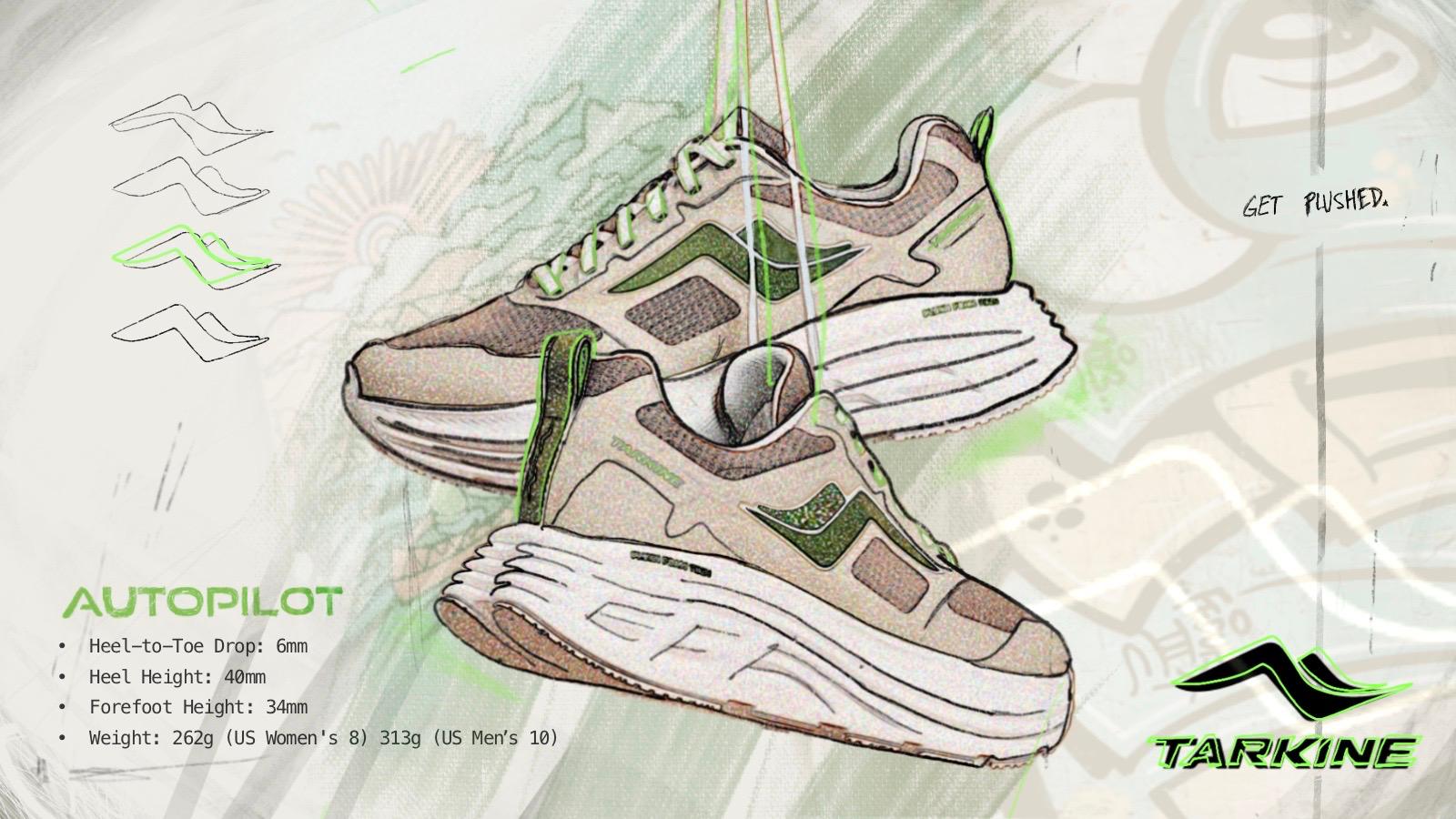
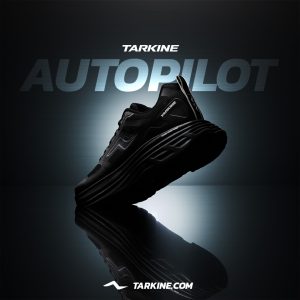

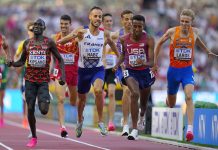
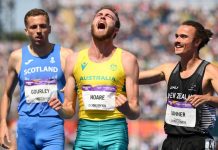
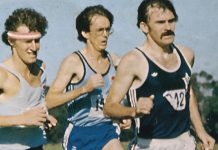
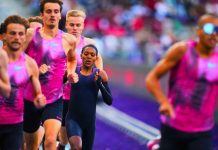
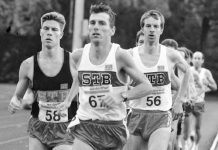
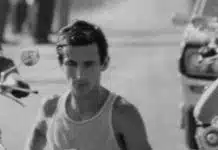
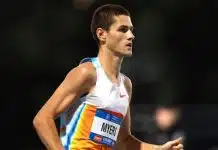
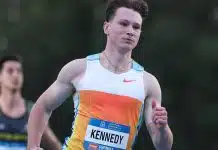
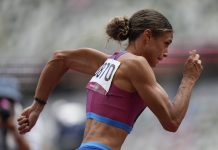

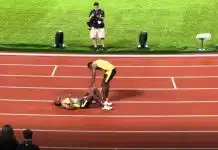
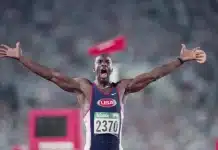
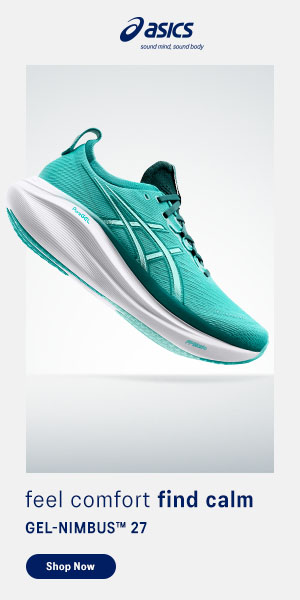
Author postscript: In the interest of accuracy I make the following correction: Margaret’s sister, Annette Dwyer, actually won the 1985 Triple M Triathlon Ironman race – she did not finish third as described in my article. Mike Beisty